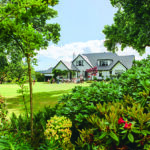This 90-year-old Taihape garden is still in its horticultural prime
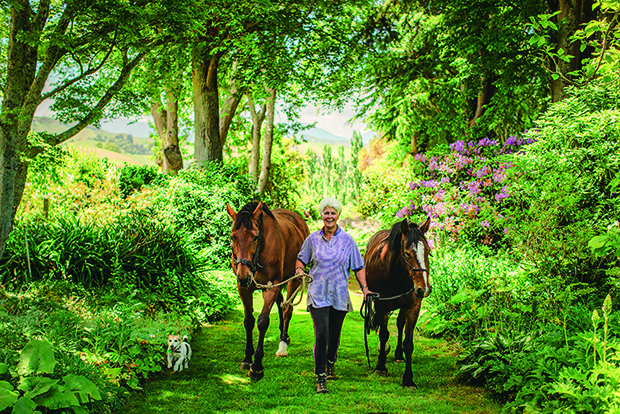
Once a competitive eventer, Amanda Collier still loves to ride. She gets out about twice a week on either old mate Yogi Bear (left) or Bella, with her jack russell/fox-terrier-cross Onyx for company.
A garden designed in 1936 is showing its age — quite beautifully — in the hands of another generation of the same clan on a farm that’s been in the family for more than 100 years.
Words: Kate Coughlan Photos: Alanah Brown
Farming was enjoying good wool cheques in 1936 when Amanda Collier’s great-uncle Bill Duncan built his bride, Joyce, a new home on his farm inland from Taihape.
Bill chose a broad plateau near the dramatic Moawhango River gorge, with a vertical drop of 70 metres and vistas in all directions. To the north and west, the site looked over rolling farmland (much of it then owned by Bill or other members of the Duncan family) towards the mountains of Ruapehu and Taranaki and, to the south and east, over the gorges and plains of the Rangitīkei. To design the house, he chose renowned Whanganui architect Robert Gordon Talboys, and to make the most of the magnificent site, he called on an equally well-known garden and landscape designer of the day, Alfred Buxton of Christchurch.
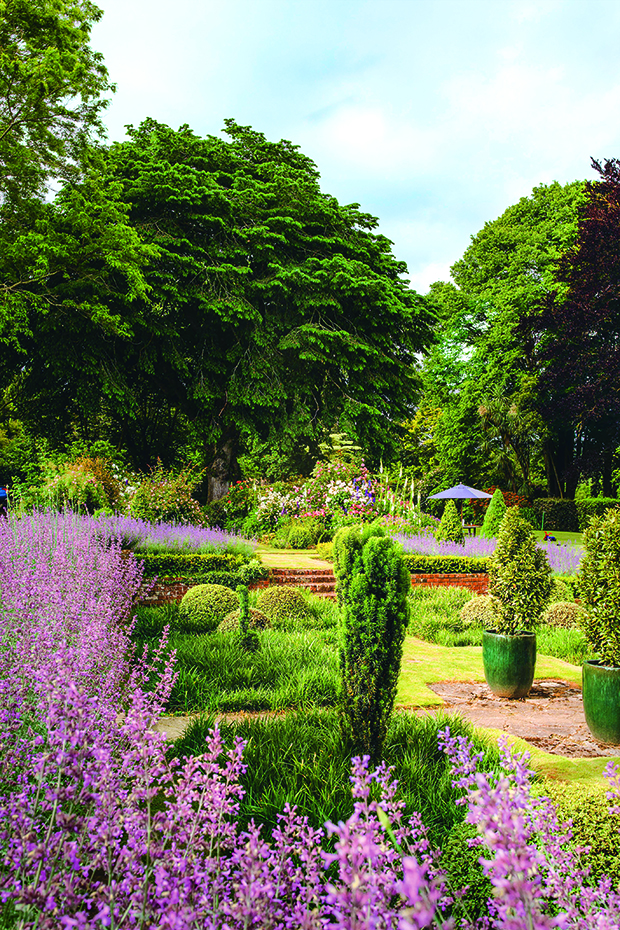
Alfred Burton’s distinctive hard landscaping elements, sunken gardens, and trees planted away from the house are maturing beautifully. Its owners especially love the evening light drifting across the frothy top of the catmint toward the perennial borders and the majestic elm.
Talboys designed many distinguished Whanganui homes and public buildings in the early part of the past century (many of which are still admired today), and he drew up plans for a handsome Arts and Crafts-inspired house. Buxton’s plans for the landscaped grounds, formal flower beds and border, a teardrop driveway, and significant tree planting programme more than matched those for the gracious home.
According to family lore, it cost more to landscape and plant the grounds to Buxton’s plan than to build the house to Talboys’ plan. Maybe it’s true; maybe it’s not. Some family tales grow faster than wisteria up the veranda post. But it certainly wouldn’t be the first time a Buxton-designed garden cost enough to set tongues wagging and eyebrows heavenwards. That was why a Buxton-landscaped property was, back in the day, a prized symbol of pastoral affluence.
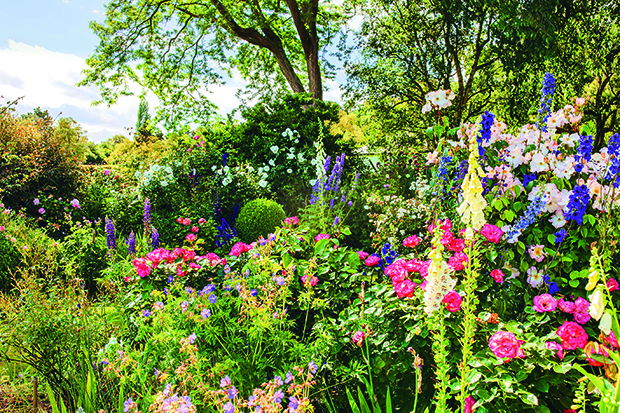
Clematis Montana, on the trellis and low buxus hedging opposite a line-up of yews, separates the formal gardens from the vegetable beds. The two perennial borders, filled with roses ‘Strawberry Ice’ (dark pink in the centre), ‘Sally Holmes’ (pale pink, tallest, on right), standard iceberg (under the Magnolia stellata to the rear), foxgloves, purple and blue delphiniums, aquilegia, geranium and iris, take the most time to manage. They are cut back in late autumn to the ground, then covered in pea straw, leaving the evergreen buxus balls standing like sentinels over winter.
Ngata (meaning “plenty” in te reo Māori) is today the home to Amanda and Rob Collier, who took over the farm in 1996 when Amanda’s parents, Andy and Di Grace, retired. The farm had come into Amanda’s family from her great-uncle Bill Duncan, who was the godfather and uncle to her father, Andy Grace. Bill and Joyce had no children and asked Andy and Di to take over in the 1970s when it came time for them to retire.
When Amanda first arrived at Ngata, she was eight years old and pony-mad. In the early years of her marriage to Rob, she was still riding in a competing career she describes as “long and often successful.”
- The couple replaced the original teardrop drive with lawns, often used for competitive games.
- Tōtara fence batten wickets are defended here by friend Janey Chrystall and assistant fielder three-year-old Bindi Murray, whose family lives in the valley.
“There was a nasty fall at a three-day event in Taupō and concussion, and that was the end of the riding,” she says. “Then along came three boys.”
Rob and Amanda had begun their farming life on Rob’s family property in the Whanganui district on a ridge in the Parapara Valley between Whanganui and Raetihi. It was a beautiful property and a good farm. But she was more than happy to return to her childhood home, even with its dauntingly large garden to care for while raising three sons (Andrew, George and Henry — all now grown-up).
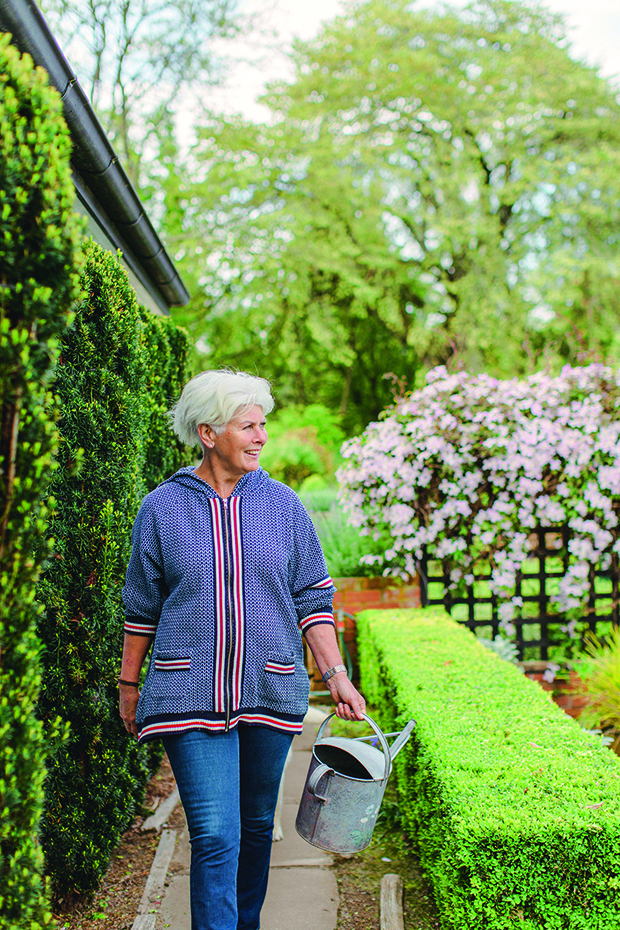
Her return to Ngata sealed the continuation of 100 years of Duncan-Grace descendants in the valley and the third generation to care for the then 60-year-old house and garden. Such a legacy didn’t daunt Amanda, whose clan includes a few women who could be noted as “Rangitīkei gardening royalty” — for example, her aunt Susanah Grace (NZ Life & Leisure, May/June 2022) and not to mention Rob’s uncle, noted gardener Gordon Collier.
In fact, she loves the property and relishes her role as custodian and keeper of its stories, especially those illustrating the generosity of her great-uncle Bill. She tells about his staff returning from the war who were given land, and the romance of shepherds Johnnie Haitana and Stuart Dean, who lived above the stables and were fed at the house, eventually marrying the cook and housemaid, Edna and Violet, whose descendants still live in the valley today. How the long drive that rises for a kilometre up from the flat to the house was planted in matching pairs of oaks by grateful staff as a wedding present for Bill and Joyce, and that the seedling oaks came from the “family seat at Hunterville”.
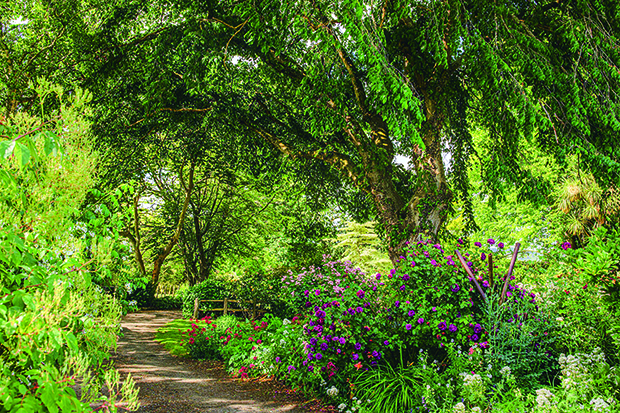
Gardens bordering the driveway tumble with plants happily existing under the canopy of tall trees, including the dark purple rose ‘Chianti’ beneath the magnificent 88-year-old elm.
This amuses Amanda, who is curious that there could be such a thing as a ‘family seat” at Hunterville. However, the Duncan family was indeed strong in the Hunterville region, and her great-grandfather Thomas Duncan, a known philanthropist, farmer-politician and racehorse breeder, was, in 1951, knighted for good works, including sending 200 bullocks to Britain, which was very short of protein, at the end of the World War II.
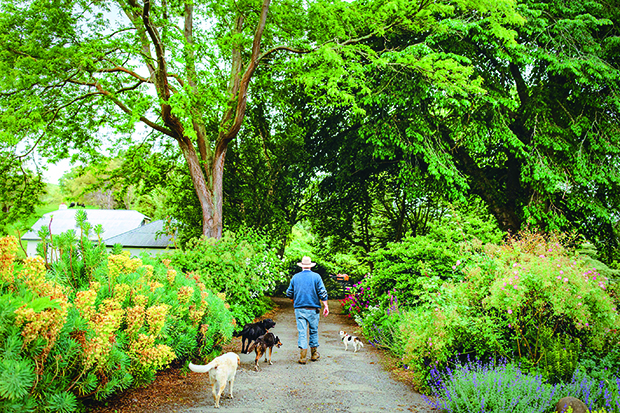
Rob, the master of lawns and anything needing a power-tool chop, is almost always followed by a troop of dogs, including his sheepdog Mia, a pair of labs and at least one jack russell.
So, there’s history, which can sometimes be an uncomfortably tight rein, but not for Amanda, who is used to loosening the reins to get the most from her horses. She did much the same for her garden. Some areas were showing their age — and not advantageously. Case in point? The sunken rose garden (sunken gardens were standard features of Buxton’s later work) with dozens of what had been prized bushes.
They were old and diseased, with ancient woody crowns demanding constant spraying — something Amanda recognised was not her favourite pastime. Out went the roses.
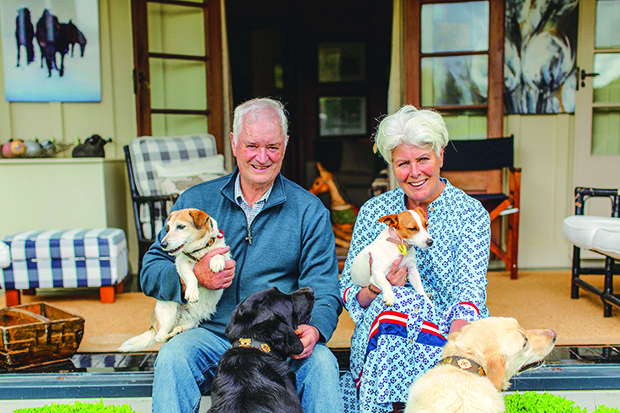
The six-year-old labradors (his is black Koby) and (hers is white Milly) are brother and sister and wear elegant Swiss calf collars. On Rob and Amanda’s knees are jack russells Onyx (Rob’s) and Binky (Amanda’s).
The sharp intake of breath on the next visit of her parents, Di and Andy, at the disappearance of the roses was but a gentle zephyr compared with what followed her removal of a massive oak. The oak was covered in a rose that Gordon Collier says might have been the finest example of a banksia rose in the entire country. “A magnificent specimen, I’ve never seen one like it,” he says. The howls of horror from her visiting parents subsided over time as everyone accepted it was for the best that afternoon light be allowed into the house and the view to the west enjoyed. “Banksia roses flower for a meagre 10 days a year,” notes Rob sanguinely, never bothered by its loss.
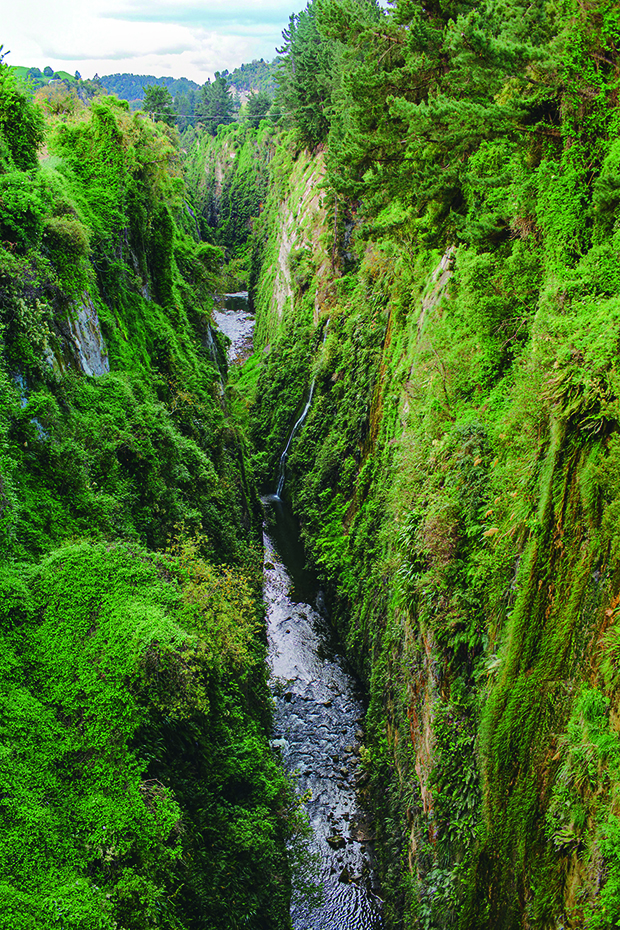
A 50-year-old swing bridge spans the 76-metre vertical plunge to the gorge of the Moawhango River to the garden’s west. It was considered a location for filming The Lord of the Rings but discounted as too dangerous.
Amanda says there are challenges in taking over a family garden and a famous one at that, so her approach has been to enhance and evolve rather than initiate a horticultural revolution.
She believes Buxton’s plan has stood the test of time, with the glorious and now-huge oaks, elms and beeches planted well away from the house (apart from the now-gone oak). However, gardens and their inhabitants have a habit of growing, and priorities change. Camellias and rhododendrons blocked views from the kitchen; out they went. The old teardrop drive that heroed the car’s front-of-house spot in the porte cochère (cars were once a prize possession rather than today’s symbol of global pollution) is gone, along with a border replanted with a simple mass of strawberry ice roses.
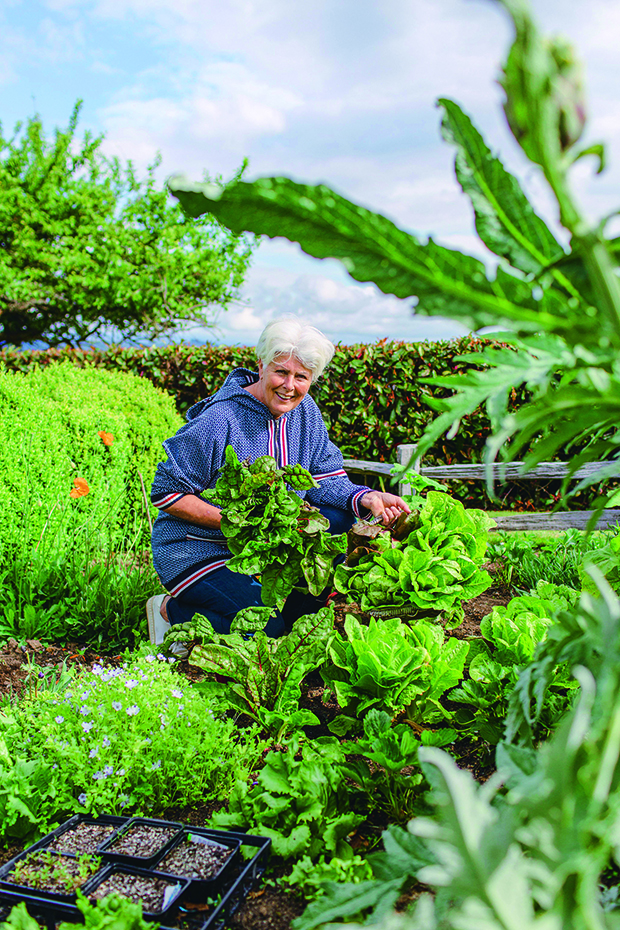
Amanda loves all gardening but especially her vegetable garden for its impressive harvests.
“When we came, the views to the far hillside were grown out and felt enclosed. Opening the view shafts has made a huge difference,” she says of the positively bucolic vistas.
Where there were once the maids’ and servants’ quarters, Amanda and Rob have developed a productive vegetable garden and, in keeping with Buxton’s use of hard-edged landscaping features, Rob inlaid tōtara to the new concrete paths.
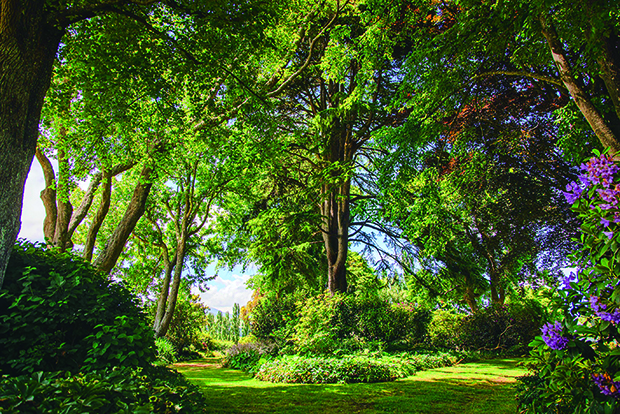
The massive cedar in the centre of the azalea bed was limbed up to provide a marquee location for son George’s wedding last February. The event happily preceded Cyclone Gabrielle by mere days. The marquee crew arrived in darkness and heavy rain to get it down before the worst of the predicted storm arrived. They were lucky they did, as in this near-Ruahine Range location, it was dramatic.
Amanda’s favourite colours are purple and green, so she turned to Pinterest for inspiration when replanting the former sunken rose beds. Imagine what Buxton would have come up with had he been able to access such a valuable source of ideas. Amanda feels he might approve of her geometric design using purple liriope, yew, golf ball pittosporum (disease-resistant) buxus and catmint.
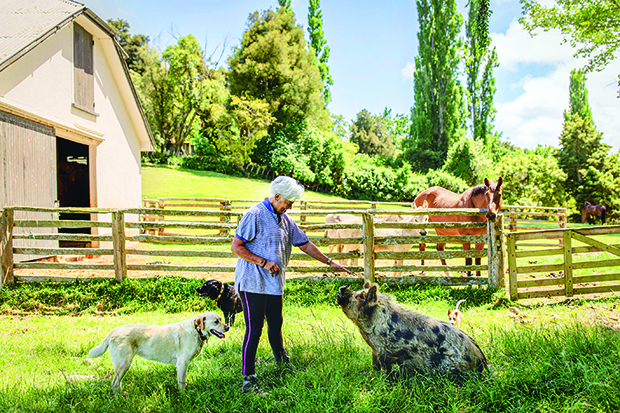
Louise, the obedient kunekune pig, is a loved pet and not destined for the dining table. However, Louise’s former sty mate Thelma was entirely different and had to go after threatening to bite Amanda. The stable was built by Amanda’s great-uncle, Bill Duncan, in the 1930s.
“I wanted to marry my favourite colours with the lines and shapes of the green plants, originally thinking of using lavender but then thought catmint might do better here in our environment where it can get down to minus-five-degrees Celsius and up to 30 degrees Celsius. It can get cold, but nothing like I recall as a child. We’d get two or three snowfalls yearly, with snow as deep as the top of my gumboots. We don’t get that much snow now — haven’t for years.”
Amanda recently joined a book club and is learning to slow down and factor in reading time and do more flyfishing. In a way, the book club has led her to appreciate these things even more.
“My favourite place in the garden now is under the enormous liriodendron on the front lawn reading a book.”
Rangitīkei Rivers Catchment Collective
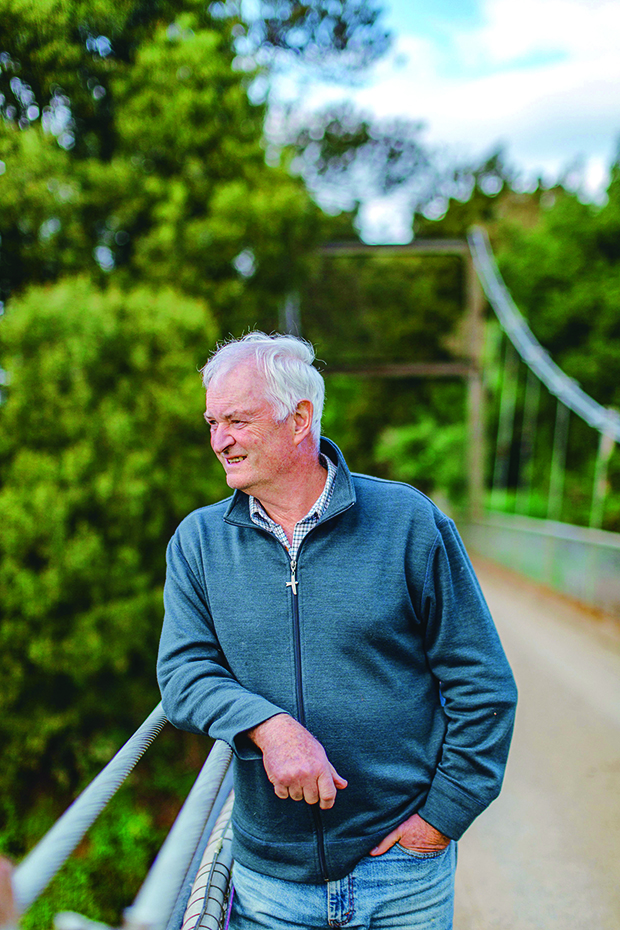
Rob Collier is an active member of this farmer-led initiative to monitor and improve the water quality in the Rangitīkei River’s many streams and tributaries.
“Water is tested at 88 sites on the first Tuesday of every month for nitrates, phosphate, E. coli, and turbidity. This has happened for the past five years, and the information is sent to farmers to inform them of what is going on within their respective catchments.
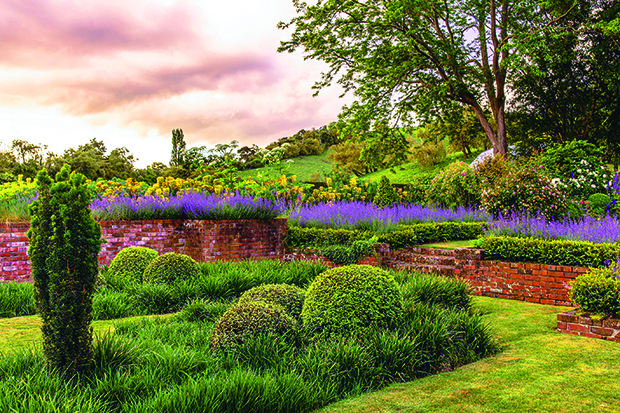
Even though the sunken garden and significant brickwork wall surrounding the four formal beds is heading into its ninth decade, it remains elegant in a purple- and green-flowering liriope and is a lot less to manage than when the beds were full of roses — as designed and planted by Buxton.
In partnership with two other families, Rob and Amanda own Spring Farms (NZ), managing six properties (3000 hectares) and wintering over 30,000 stock units. Spring Farms owns the stock and plant but leases the land from various owners. Approximately 20 kilometres of streams on Spring Farms are fenced in riparian planting each year, with about 4000 native trees going in annually.
“All farmers know that we need to move in this direction, so water monitoring and soil mapping are a routine aspect of our care of the land. Farmers are under pressure to meet freshwater targets, and the information we get from testing helps refine how we graze the land, such as fencing off critical areas and minimising sediment with traps. Turbidity is the main issue with this land as it is steep. Everybody is committed to this process, and the response to it is unbelievable.”
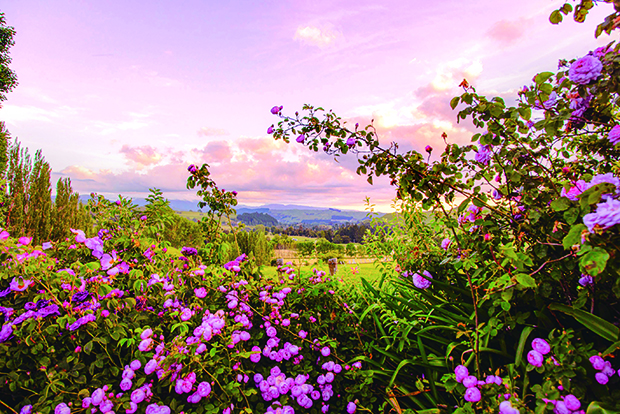
The southerly view is framed by a mesmerising array of pink and purple-hued roses inspired by an Ohoka garden Amanda fell in love with years ago. Centre stage is the rose ‘Raubritter’, with ‘Complicata’ on the left and the tall bush on the right is ‘Belle Amour’.
The story of the waterway protection is not the only good news in conservation terms either; when Amanda grew up on Ngata, the place heaved with possums. Thanks to the efforts of Horizons Regional Council (the local regional council), it is rare, almost unheard of, to see or hear a possum on Ngata these days.
Recently, Rob has begun a small tourism operation offering four-wheel drive tours of the very picturesque landscape of their farm, including the heart-stopping and breathtaking 76-metre-deep sheer-sided Moawhango River gorge and the headwaters of the beautiful nearby Kawhatau River. Guests get to see the methods being employed by modern-day farmers caring for their land.
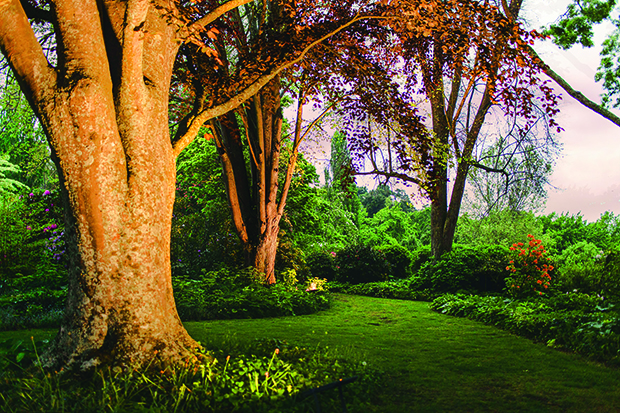
The beauty of the copper beech (foreground) and pair of lime trees can now be appreciated after uplighting was put into the garden last year before George’s wedding.
“These initiatives should be shared with a wide audience. Not just to other farmers but also to our consumer markets here and abroad — where such custodianship is valued.”
Spring Farms was one of the first farms to be NZFAP Plus accredited, which covers red meat and wool producers independently, verifying best-practice animal raising and product assurances (origin, traceability, biosecurity, environmental sustainability and animal health and welfare) for international consumers. farmtours.nz
 This article first appeared in NZ Life & Leisure Magazine.
This article first appeared in NZ Life & Leisure Magazine.
